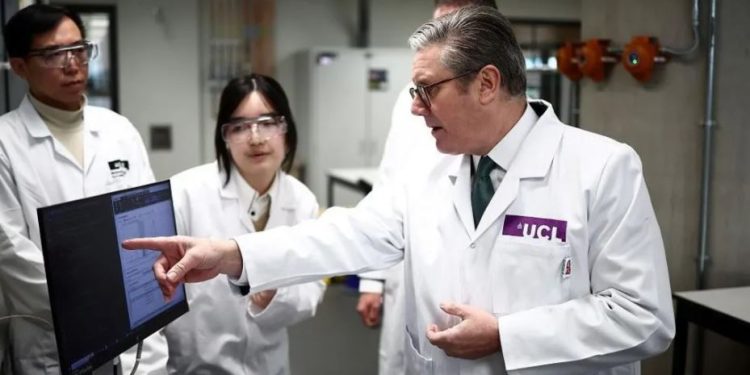Sir Keir Starmer’s vision to make the UK a global leader in Artificial Intelligence (AI) may unintentionally exacerbate the country’s water scarcity issues, according to industry sources speaking to the BBC. The rapid expansion of data centers to support AI requires large amounts of water for cooling, raising concerns about the impact on the UK’s already stretched water resources.

The government’s plans to build multiple new data centers across the country as part of an economic growth strategy have led to questions about the long-term sustainability of these projects. While the tech industry is working on more water-efficient cooling systems, concerns remain about the water demand in areas already facing potential shortages, especially in southern regions.
To address these concerns, the government is backing plans for nine new reservoirs, but some of these are located near AI “growth zones,” including Culham, Oxfordshire, where a new AI hub will be established. This raises concerns about how much water these large-scale data centers could draw from reservoirs, including the one planned at Abingdon.
The Royal Academy of Engineering has called on the government to enforce environmental sustainability measures for all data centers, urging companies to accurately report their energy and water consumption and take steps to reduce reliance on drinking water for cooling purposes.
Without such action, warns one of the report’s authors, Prof Tom Rodden, “we face a real risk that our development, deployment and use of AI could do irreparable damage to the environment.”
The tech industry tends to be cagey about water consumption. Most UK data centres contacted for this article did not respond to our inquiries.
Data centres use fresh, mains water, rather than surface water, so that the pipes, pumps and heat exchangers used to cool racks of servers do not get clogged up with contaminants.
The amount used can vary considerably depending on a number of factors including the surrounding environment; sites in colder, wetter parts of the world tend to require less.
Dr Venkatesh Uddameri, a Texas-based expert in water resources management, says a typical data centre can use between 11 million and 19 million litres of water per day, roughly the same as a town of 30,000 to 50,000 people.
His widely quoted calculations are based on arid, or semi arid, climates and do not take into account recent efficiency improvements or developments in AI.
Microsoft’s global water use soared by 34% while it was developing its initial AI tools, and a data centre cluster in Iowa used 6% of the district’s water supply in one month during the training of OpenAI’s GPT-4.
Local resistance to data centres is growing around the world, particularly in areas where water is scarce.
In Chile, Google stopped building a data centre following concerns about its water use, and it redesigned the cooling system at another in Uruguay following local protests.
In the UK, Thames Water has warned data centres they could face restrictions on use during heatwaves.
In 2022, the company said it would review data centres’ water use as it prepared to introduce a hosepipe ban during a summer draught.
But Foxglove, a group of campaigning lawyers, found evidence from Thames Water’s strategy documents the following year that the firm still did not appear to know how much water its existing data centre customers were using.
Thames Water declined to comment. It signposted its recent five-year plan, which has been approved by the government.
This states that it has no legal obligation to service businesses, and can choose to restrict or refuse water to commercial customers; but this was written before the government designated data centres as Critical National Infrastructure, meaning they will face fewer planning restrictions.
Thames Water filed an objection to a planning application for a new data centre in a cluster in Slough, near Reading, in 2021.
But other proposals in the area have since succeeded: for example in August 2024 the firm Yondr announced that it would be building its third data centre campus there.
Foxglove CEO Martha Dark said: “The government must urgently explain how its plans for new data centres will not threaten our long-term supplies of drinking water.”
A government spokesperson said: “We recognise that data centres face sustainability challenges such as energy demands and water use – that’s why AI Growth Zones are designed to attract investment in areas where existing energy and water infrastructure is already in place.”
In addition, recent changes made by the water regulator Ofwat would “unlock £104bn of spending by water companies” in the next five years.
The data centre industry argues that modern sites are already more efficient. Alternative cooling methods which do not require much water, such as free air cooling and dry cooling, are evolving.
Closed-loop cooling, which involves reusing water, will be deployed in Microsoft’s new data centres in Phoenix and Wisconsin.
Aaron Binckley, vice president of sustainability at Digital Realty, acknowledged criticism around data centres’ water usage but claimed that the sector was making “significant strides”.
His company, which has 300 data centres worldwide, is trialling a new AI tool which analyses operational data and identifies water-saving measures. He says it is predicted to conserve nearly 4m litres of water per year.
Clearly, that is currently an expectation rather than a reality, but Mr Binckley says it proves that “AI can drive sustainability as well as technological progress”.
In 2024 the Environment Agency wrote in a blog that by 2050, England alone would need an extra five billion litres of water every day – it says this is the equivalent of two million wheelie bins-full – just to serve the population.
But the regulator now needs more data in order to factor in new data centres’ future needs.
For the time being, it is urging data centres to forecast and plan their water consumption – and to explore their own sources of water, such as water reuse.
“Meeting the increased water demand is not just for the water industry to solve,” says a source.























































![[FREE FREE MONEY] Predict and Win a Guaranteed GH¢200 From Us EVERY WEEK](https://wordpress.ghanatalksradio.com/wp-content/uploads/2022/02/Predict-and-Win-Final-09-03-2021-218x150.jpg)
![[Predict & Win – 8th/Oct.] WIN A Guaranteed ¢200 From Us This Week](https://wordpress.ghanatalksradio.com/wp-content/uploads/2021/10/maxresdefault-16-218x150.jpg)
![[Predict & Win – 2nd] WIN A Guaranteed ¢200 From Us This Week](https://wordpress.ghanatalksradio.com/wp-content/uploads/2021/09/maxresdefault-50-218x150.jpg)
![[Predict & Win – 25th] WIN A Guaranteed ¢200 From Us This Week](https://wordpress.ghanatalksradio.com/wp-content/uploads/2021/09/maxresdefault-36-218x150.jpg)
![[Predict & Win – 18th] WIN A Guaranteed ¢200 From Us This Week](https://wordpress.ghanatalksradio.com/wp-content/uploads/2021/09/maxresdefault-23-218x150.jpg)










![[National cathedral] See full list of churches that have contributed since 2018](https://wordpress.ghanatalksradio.com/wp-content/uploads/2020/09/Ghana-National-Cathedral-GhanaTalksRadio-100x70.jpg)



